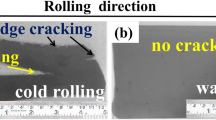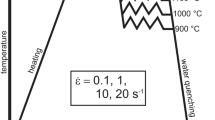Abstract
Geometry and size effects on the crack growth resistance curves in CT-specimens of a low and high strength material are numerically investigated. The fracture process is controlled by experimentally determined critical values of the crack tip opening displacement (CTODi for crack growth initiation and the crack tip opening angle (CTOAC) for stable crack growth. The results show that for the low and the high strength material the geometry and size effects are different. This is mainly due to the fact that the load vs. load line displacement records are basically different for the two materials which results from the large difference in the scaled fracture toughness parameters, CTODi/εO and CTOAC/εO, of the two materials.
Similar content being viewed by others
References
C.E. Turner, Fracture Behavior and Design of Materials and Structures, Proceedings of ECF 8, Vol. II, EMAS, U.K. (1990) 933–968.
O. Kolednik, International Journal of Fracture 63 (1993) 263–274.
G.X. Shan, O. Kolednik, H.P. Stüwe and F.D. Fischer, Engineering Fracture Mechanics 41 (1992) 625–633.
G.X. Shan, O. Kolednik, F.D. Fischer and H.P. Stüwe, Engineering Fracture Mechanics 45 (1993) 99–106.
G.X. Shan, O. Kolednik and F.D. Fischer, ASTM STP 1244 (1994) in press.
G.X. Shan, O. Kolednik and F.D. Fischer, International Journal of Fracture 66 (1994) 173–187.
O. Kolednik and H.P. Stüwe, Engineering Fracture Mechanics 21 (1985) 145–155.
H.D. Hibbitt, B.I. Karlsson and E.P. Sorensen, ABAQUS User's Manual Vers. 5.2. (1993).
O. Kolednik and P. Kutleša, Engineering Fracture Mechanics 33 (1989) 215–223.
G.P. Gibson, S.G. Druce and C.E. Turner, International Journal of Fracture 32 (1987) 219–240.
L. Braga and C.E. Turner, ASTM STP 1131 (1992) 178–197.
G.X. Shan, O. Kolednik and F.D. Fischer, Numerical investigations of stable crack growth in CT-specimens of SAE4340 steel, Localized Damage III, Computer Aided Assessment and Control, Computational Mechanics Publications, Boston (1994) 399–406.
ESIS P2-92, ESIS procedure for determining the fracture behaviour of materials, Delft, The Netherlands (1992).
Standard test method for J IC, a measure of fracture toughness, in ASTM E813-87, Annual Book of ASTM-Standards, Section 3, Vol. 03.01, Philadelphia, PA (1987) 968–990.
A.P. Green and B.B. Hundy, Journal of the Mechanics and Physics of Solids 4 (1956) 128–144.
P.C. Paris, H. Tada, A. Zahoor and H. Ernst, ASTM STP 668 (1979) 5–36.
C.F. Shih, Journal of the Mechanics and Physics of Solids 29 (1981) 305–326.
C.E. Turner, R-curve, energy dissipation rate and crack opening angle models for large amounts of ductile crack growth in bending. Fracture Mechanics: Twenty-Forth Symposium, ASTM, Philadelphia (1992) to be published.
Author information
Authors and Affiliations
Rights and permissions
About this article
Cite this article
Shan, G.X., Kolednik, O. & Fischer, F.D. A numerical study on the crack growth behavior of a low and a high strength steel. Int J Fract 78, 335–346 (1996). https://doi.org/10.1007/BF00032482
Received:
Accepted:
Issue Date:
DOI: https://doi.org/10.1007/BF00032482




